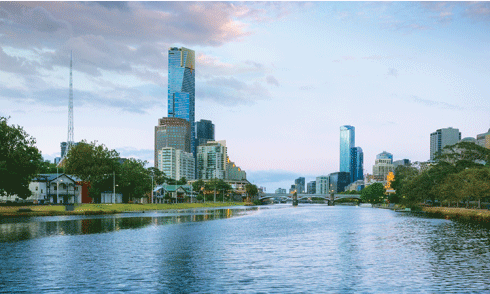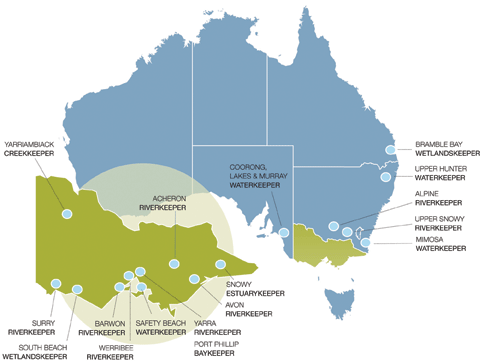
|
Published:
Championing urban rivers
Historically maligned as natural drains, our urban rivers are in fact fundamental ecological, social and economic assets that need protection, appreciation and enhanced management approaches. Robin Taylor reports.

|
|
Melbourne’s Yarra River provides critical ecological, social and economic amenity, and yet it is the subject of concern over severely reduced flows. Credit: iStockphoto
|
Good rains across much of eastern and southern Australia over the last year have allowed many rivers to flow for the first time in years. But in major cities where roads and pavements have replaced the natural vegetation, a sudden heavy rain spells bad news for river quality, and by extension impacts on the coastal areas that receive river water.
Sydney’s urban runoff has been likened to secondary treated effluent1 – the capacity of sewerage systems is exceeded during peak flows resulting in overflows to creeks and rivers. And the situation is similar for most of Australia’s major cities, where people would not think of swimming in, let alone drinking, from suburban rivers.
Unlike rural catchments, where most of the rainfall soaks into the ground, in cities even small amounts of rainfall generate runoff. Particularly for small urban streams, small amounts of impervious surfaces can have dramatic impacts on the streams’ ecological health.
In fact, Alan Hoban, Manager of Water by Design at the South East Queensland Healthy Waterways Partnership, says results from studies of streams in Victoria have shown that if even one per cent of a catchment comprises impervious areas connected to the stream by pipe work, then those streams are significantly less likely to have important species such as platypus. He believes the solution is to harvest stormwater and reuse it – a convenient fit to the growing need for more urban water supply.
‘It is an important case for water sensitive urban design, to redesign the way our drainage systems operate,’ says Mr Hoban.

|
|
The Brisbane River runs over 340 km, and crosses through a range of agricultural and dense urban areas before meeting Moreton Bay in Brisbane. Credit: iStockphoto
|
In a session on urban rivers at the 12th International Riversymposium, held in Brisbane in September, presenters from Australia spoke about issues such as design challenges, setting long-term visions for urban rivers and improving river health monitoring.
Dr Shadananan Nair from the Nansen Environmental Research Centre in Cochin, India, discussed the very different challenges of managing urban rivers in developing countries where many cities face serious shortages of reliable water.
The huge issues for urban rivers in India and other parts of Asia are associated not just with surface pollution and massive rates of urbanisation, but also with rising sea levels and other climate change impacts, poverty, corruption, poor sanitation and chronic health problems.
Managing our urban rivers
In Australia, partnerships between government, industry and community are forging the way to improve the health of urban waterways.
The Healthy Waterways Partnership (winner of the 2009 Banksia Environmental Award for Water), for example, produces annual report cards for freshwater as well as estuarine and marine waterways in south-east Queensland, giving them a grading from A to F.
Alan Hoban says that over the past 10 years, in response to water quality monitoring, there has been significant investment in upgrading wastewater treatment plants to reduce discharge loads, and that the report card played a significant role in recognising and addressing this important issue.
In Tasmania, the Derwent Estuary Program – a regional estuary management partnership between local and state governments, commercial and industrial enterprises and community-based groups – has a similar scheme, producing an annual report card, to provide information on the river’s health.
Brisbane City Council’s Creek Ranger program is a community capacity-building environmental initiative, led by council officers – the ‘creek rangers’ – who monitor reaches of their waterways and lead community activity along them. Meanwhile, the Hunter and Central Coast Regional Environmental Management Strategy (HCCREMS) is a larger regional initiative being implemented by 14 councils in the Hunter, central and lower north coasts of New South Wales. It has an integrated water management program across the 14 councils that is raising the profile of sustainable water management. It is also developing an urban water cycle approach to management programs and practices in councils, and helping greater understanding of water sensitive urban design policies and practices.
Water Sensitive Urban Design (WSUD) in Sydney is an initiative of the Sydney Metropolitan Catchment Management Authority. Its aim is to encourage councils to promote and implement more sustainable water management practices in their operations and in urban development projects in Sydney.

|
|
Adelaide’s River Torrens. Many species of wildlife rely on the health and natural flow of urban rivers. Credit: iStockphoto
|
Waterkeepers’ protection
Waterkeepers Australia, based in Victoria, formed in 2003 under the international Waterkeepers Alliance, ‘a global movement of on-the-water advocates who patrol and protect over 100 000 miles of rivers, streams and coastlines in North and South America, Europe, Australia, Asia and Africa.’ The Australian organisation has supported the establishment of 17 groups engaged in protecting and preserving the country’s precious waterways (see map). Now that the groups are becoming self-sufficient, Waterkeepers Australia is divesting its support role to other more local NGOs and state agencies.

|
|
Waterkeepers Australia has supported the formation of 17 local riverine advocacy groups. Credit: Waterkeepers Australia
|
Melbourne’s Yarra River is supported by one of the 17 advocacy groups. The Yarra Riverkeeper Association, currently funded from public donations as well as grants from Melbourne Water and the EPA, aims to give the iconic, and often maligned, Victorian river a voice.
Spokesman for the group, Riverkeeper Ian Penrose, says: ‘Our role is awareness raising and trying to make people change their behaviours – to save water and also to participate in the public discussions about water management. People protect what they love so a lot of our message is about loving the river and seeing its important values.’
Mr Penrose says the three main issues for the Yarra are water quality, flows and damage to the riparian vegetation.
‘In all three, the river is suffering, but the issues of flows and loss of riparian vegetation are the more challenging ones, where easy solutions are not obvious,’ he says.
The Yarra is the main source of water supply for Melbourne, and Mr Penrose says low rainfall conditions in recent years have created enormous tension between the amount of water Melbourne needs for supply and what the river needs for environmental health. Last year, flows were only 11 per cent of its natural, average volume.
Another area of concern as the city continues to grow is the health of the river banks and associated wetlands, which are an important part of river ecology. ‘They are continuing to lose out as the city ignores the bushland and drains more of the swamps,’ Mr Penrose says. ‘As the city gets bigger and more trees are pulled down, the river suffers.’
Using the group’s boat, Project Officer Rod Ingham regularly patrols the reaches of the lower Yarra, monitoring changes – both positive and negative – which he feeds to river and environmental authorities, and other stakeholders. His small efforts are making a big difference.
More information:
Healthy Waterways Partnership,
www.healthywaterways.org
International Riverfoundation,
www.riverfoundation.org.au
Waterkeepers Alliance, www.waterkeeper.org
Yarra Riverkeepers, www.yarrariver.org.au
1 Findlay SJ and Taylor MP (2006) Why rehabilitate urban river systems? Area 38: 312.




